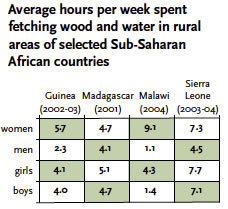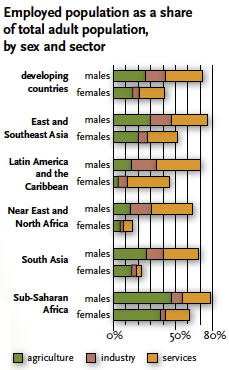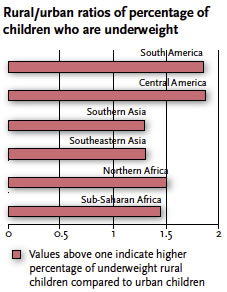The theme for International Women's Day this year is: Empower Rural Women - End Hunger and Poverty. Below I have included Goal 1 from the United Nations Millennium Development Goals.
"In many countries women supply most of the labour needed to produce food
crops and often control the use and sale of food produce grown on plots
they manage. However, the gender disparities in ownership of, access
to, and control of livelihood assets (such as land, water, energy,
credit, knowledge, and labour) negatively affect women's food
production."
Goal 1: Eradicate Extreme Poverty and Hunger
Rural Women's Poor Access to Infrastructure in Rural Areas Limits their Opportunities to Reduce Poverty and Hunger
Rural women spend more time than urban women and men in
reproductive and household work, including time spent obtaining water
and fuel, caring for children
and the sick, and processing food. This is because of poor rural
infrastructure and services as well as culturally assigned roles that
severely limit women's participation in employment opportunities (see
also Goals 3 and 7).
Faced with a lack of services and infrastructure, rural
women carry a great part of the burden of providing water and fuel for
their households. In rural areas of Guinea, for example, women spend
more than twice as much time fetching wood and water per week than men,
while in Malawi they spend over eight times more than men on the same
tasks. Girls in rural Malawi also spend over three times more time than
boys fetching wood and water (
Figure 1). Collectively, women from Sub-Saharan Africa spend about 40 billion hours a year collecting water [
2].
For these reasons and because rural women tend to
underreport their employment as contributing family members, according
to available data female employment in agriculture is consistently lower
than it is for men across the total adult population in developing
countries, although it varies greatly by region (
Figure 2).
The jobs of rural women who are employed tend to be shorter term, more
precarious and less protected than those of rural men and urban people.
The lack of flexible hours to accommodate family work combined with wage
and job discrimination and limited representation of women in workers'
organizations are partly responsible for this.
As an Important Source of Livelihoods for the
Poorest, Agriculture is a Means to Eradicate Extreme Poverty, Especially
for Rural Women
Despite women's lower overall employment rates, among
employed women the proportion working in agriculture as opposed to other
sectors is usually equal to or higher than the male equivalent. Almost
70 percent of employed women in South Asia and more than 60 percent of
employed women in Sub-Saharan Africa work in agriculture [
3].
The substantial involvement of rural women in agriculture, primarily as
unpaid or contributing family workers, highlights the importance of
developing policies and programmes that address the needs, interests and
constraints of women as well as men in the agriculture sector. This
includes revamping and strengthening extension systems to be more
responsive to and inclusive of women, addressing structural barriers to
women's access to productive resources, and improving financial systems
to respond to the needs of rural women producers and entrepreneurs,
including to move out of the less productive segments of the rural
economy [
4].
Improving Rural Women's Access to Productive Resources is Central to Addressing Hunger
On average, women make up about 43 percent of the
agricultural labour force in developing countries. Evidence indicates
that if these women had the same access to productive resources as men,
they could increase yields on their farms by 20 to 30 percent, raising
total agricultural output in developing countries by 2.5 to 4 percent,
in turn reducing the number of hungry people in the world by 12 to 17
percent [
5].
For rural women and men, land is perhaps the most important household
asset to support production and provide for food, nutrition and income
security. Yet an international comparison of agricultural census data
shows that due to a range of legal and cultural constraints in land
inheritance, ownership and use, less than 20 percent of landholders are
women [
6].
Women represent fewer than 5 percent of all agricultural land holders
in North Africa and West Asia, while across Sub-Saharan Africa, women
average 15 percent of agricultural land holders [
7].
Extensive evidence shows that rural female-headed
households also have more limited access than male-headed households to a
whole range of critical productive assets and services required for
rural livelihoods, including fertilizer, livestock, mechanical
equipment, improved seed varieties, extension services and agricultural
education [
8].
Similarly, in seven out of nine countries across Africa, Asia and
Latin America, female-headed households were less likely to use credit
than male-headed households [
9].
Rural Women's Economic Empowerment Can Help Reduce the Number of Underweight Children
A large body of research indicates that putting more
income in the hands of women translates into improved child nutrition,
health and education [
10], yet data on child nutrition disaggregated by both rural/urban location and sex are sparse. In all developing regions [
11]
of the world, rural children are more likely to be underweight than
their urban counterparts. From 1990 to 2008, the proportion of children
under five in developing regions who were underweight declined from 31
per cent to 26 per cent, yet in parts of Latin America and the
Caribbean, and Asia, the disparity between rural and urban children
increased [
12].
Figure 3
indicates that in South and Central America, rural children are about
1.8 times more likely to be underweight than their urban counterparts;
other regions do not fare much better. Improvements in maternal
nutrition, access to water and sanitation and health services, all of
which are lacking in many rural areas in least developed countries
(LDCs), would also contribute greatly to addressing this situation.
Steph (Wheler) Langdon, RD
something nutrishus counselling & coaching
www.nutrishus.com



















